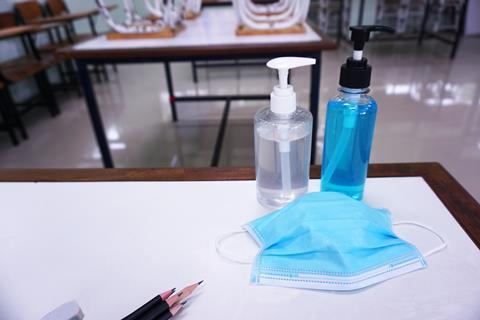Handwashing, social distancing and masks – a technician shares their view of what practical classes might look like next year

At my school, we spent inset days at the end of the summer term planning the new teaching environment in September.
Senior leadership of our multi-academy trust has determined new working guidelines for the umpteenth time. Pupils will be in their year-group bubbles. Students stay in the same class all day and teachers move about. This includes lunch and break. In theory they make sense.
However, following HSE regulations, CLEAPSS has continued to stipulate no eating and drinking in labs, even if only physics practicals take place there. In the current climate, I think there should be flexibility on this as we balance the risks – Covid infection if students move about in the school, or chemical ingestion in a chemical-free lab. We did not come to any conclusion on this debatable topic as we expect new guidelines over the summer holidays.
Face to face
Whatever practices we ultimately agree on, the student population will play a big role in their feasibility. The pupil behaviour in my school is bad enough during normal circumstances; I won’t be surprised if they spit, cough or sneeze into people’s faces deliberately. Having been on the duty rota for keyworkers’ children, I know that even good pupils get carried away and forget their spacing.
As we will all be in enclosed spaces with the difficulties in behaviour and social distancing, I am concerned. Face coverings are mandatory in indoor places, yet in schools they are down to the discretion of senior leadership team. My school has made it mandatory for students not to wear them, as they believed there will be associated behavioural issues. As such, staff have to set an example and not wear them either. During the school day, there isn’t any time where I can do my job away from the students. I will be moving between labs throughout the day, delivering and collecting equipment. I will be exposed to all the staff and students and them me, whether in the classroom or along the corridor. I would feel safer if masks were made mandatory in schools.
Hands-on
We have had several discussions about lab practicals. Will it be demos only, or no sharing of equipment? If teachers are only allowed to do demos, schools with poor technician service factors (the ASE recommends 0.85) will breathe a sigh of relief; they won’t have to run around like headless chickens just to keep things under control. In the lesson, however, due to social distancing, students won’t be allowed to crowd round the teacher’s bench. If they can’t see properly, the impact is lost. Seeing experiments via visualisers or YouTube videos will not be the same. Furthermore, without the hands-on experience, students go into their next level of education without the appropriate practical experience.
The best compromise for science practicals would be to let students take turns
The other extreme is to let students work individually. In this scenario, we will have to undertake extra tasks to prevent cross infection. For example, to minimise movement, class sets of solids have to be pre-weighed. In addition, there will not be enough equipment to go round, such as microscopes, prisms or forcemeters. Even though students are still to practise hand hygiene, CLEAPSS has advised that everything they touch needs to be disinfected or quarantined. We are unlikely to have the luxury of enough equipment to set aside in quarantine after each practical. We will need to disinfect down to every last retort stand, base and clamp, Bunsen burner, tripod and mat. From the workload point-of-view this is astronomical.
The Gatsby Foundation’s 2017 Good Practical Science emphasises ‘hands-on practical work is an essential part of learning science’. This is critical for students who intend to take the subject to the next level. The best compromise for science practicals would be to prepare a few sets and let students take turns to do the demos. This way, a handful will get to do new practicals each lesson. Other students get to watch it more than once, which reinforces the learning. If mistakes are made, they also serve as learning points. For those who plan to drop the subject after the exams, or those who do not enjoy practical work, we could turn this into an advantage for them. Let them sit and watch others; those who are interested can do it. This way, everybody wins. Technicians’ workload is manageable, teachers still deliver the lessons and students get a choice on doing the practicals.
The recent Ofqual consultation decision proposes only observations and simulations for chemistry GCSE and AS students, with a ‘minimum number of practical activities’ being required at A-level. Instead of diving straight into those required practicals in the autumn, they should be done later in the academic year, when we have settled into the new Covid-safe routines. Let the voluntary demo practicals or technique observations this autumn serve as warm-ups.
As a department, we will come to a new working agreement to accommodate any fresh set of guidance. I am confident that together my teachers and I will get the best teaching done in this Covid climate.
This article was updated on 2 September.









1 Reader's comment